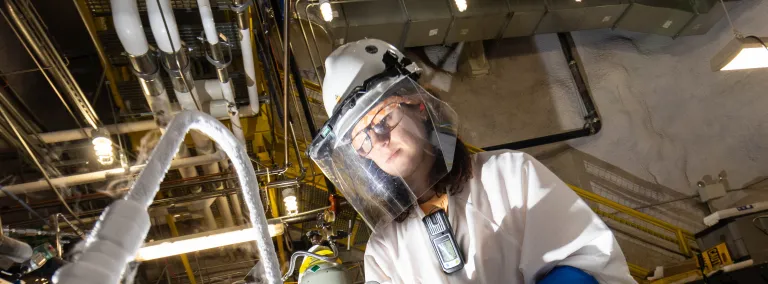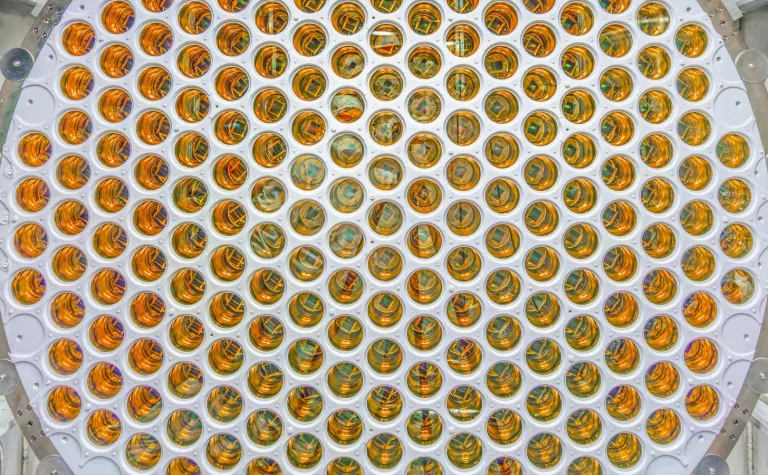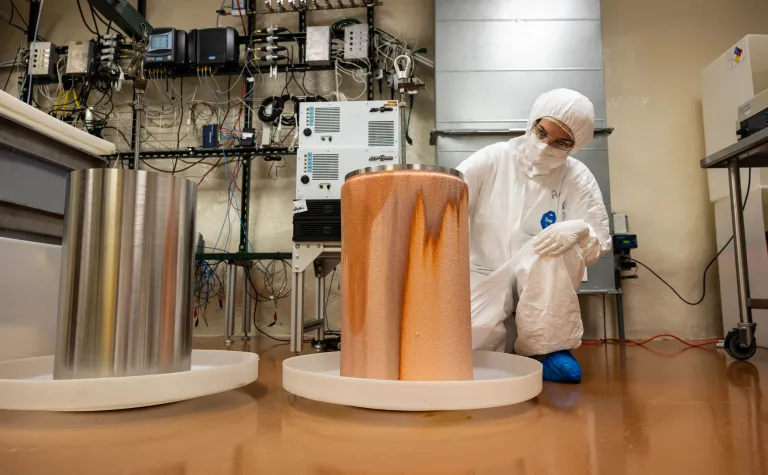Meet the frontline workers at the beating heart of the world’s leading dark matter detector
LUX ZEPLIN (LZ) is maintained by a talented team of scientists, engineers, technicians, and students whose tireless labor keeps the experiment running a mile underground.
For most of us, the morning commute involves mundane routine—the same stoplights, sidewalks, streets, and buildings each day. For Julia Delgaudio and others who work at the Sanford Underground Research Facility (SURF), the commute frequently involves descending nearly a mile below the surface, to the deepest laboratory in the United States. This 10-minute journey underground, inside an elevator called a cage, is not always routine.
“Some days you get to meet new people, scientists, technicians, other workers, and you can start up interesting conversations. There is a lot of sharing of perspectives on the cage,” said Delgaudio who is an engineer working as an experiment support scientist at SURF.
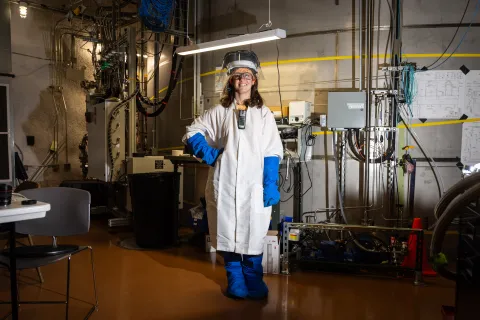
Olivia Valentino, a second-year Ph.D. student studying particle physics at Imperial College London, poses for the camera in full PPE required for work on some aspects of LZ.
Photo by Stephen Kenny
SURF is America’s Underground Lab, with some 200 full-time personnel and thousands of scientists from around the world who frequent the facility. The cage ride down can include a wide range of people, from physicists advancing cutting-edge research, to former miners, who help maintain the sprawling underground facility.
SURF is huge, encompassing some 370 miles of tunnels and shafts that were once North America’s deepest gold mine. Today, the facility is no longer an active mine but is dedicated to advancing world-class science and education.
Dark Matter Research at SURF
LUX ZEPLIN (LZ), the leading dark matter experiment on the planet, is one of the prominent physics research projects underway at SURF. LZ is located 4850 feet below the surface, and the experiment is trying to prove the existence of dark matter, which is among the most pertinent questions in physics today.
For many, dark matter is a hard concept to grasp, and for good reason; it’s invisible in everyday life, undetectable in every normal sense. But for physicists and astronomers—who peer into the depths of the universe—there is strong evidence for its existence.
That evidence is in the math. Galileo postulated that math is the language of the universe, and in the simplest sense, the math is not working out. The spiral galaxies we see in the universe are moving in ways that indicate a huge amount of extra mass out there that we cannot see.
Imagine if a feather floating in the wind, landed on a rowboat and suddenly caused it to sink into the pond. This analogy, while not perfect, is similar to the mystery in the motion of some celestial bodies, and scientists think dark matter is the most likely candidate to explain the missing mass and movement of spiral galaxies.
But despite this, and other evidence for dark matter, no one has yet proven its existence. Scientists around the world are searching for dark matter in a multitude of ways. Various types of telescopes, particle colliders, and specialized scientific instruments, located on Earth and in space are all part of the hunt for dark matter. Dark matter experiments are often placed deep underground, where they are shielded from the constant bombardment of cosmic rays that would drown out the ability to detect the rare signals needed to indicate its existence. SURF is just one of many laboratories around the world in the hunt for dark matter.
The boots-on-the-ground personnel who make it happen
Operating the world’s leading dark matter experiment, LZ, in a deep underground environment is no small task. (See more in this video.)
In the simplest sense LZ is designed like an onion with several layers surrounding a core that holds 10 metric tons of liquid xenon. Researchers believe some of the particles of dark matter streaming through every square inch of the universe will interact with some of the xenon atoms. You can think of this interaction like two pool balls colliding. When this reaction happens, it will create a tiny flash of light at the center of the xenon chamber, possibly indicating dark matter.
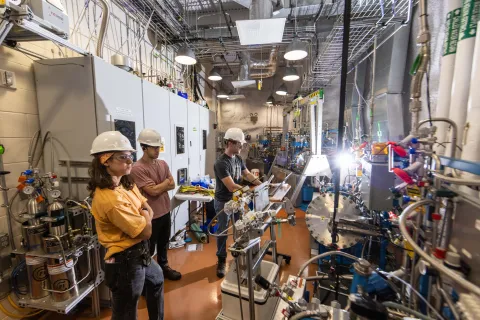
Scientists working on LZ are shown here alongside some of the equipment they maintain.
photo by Stephen Kenny
This ultrapure liquified xenon is akin to the lifeblood for this experiment, and its heart, which keeps this blood flowing, is a specialized set of compressors. Gavin Cox, a physicist and experiment support scientist at SURF, is one of those who keeps this heart beating. Standing in front of a running xenon compressor, he sounds like he could be inside a mechanic’s garage, preparing to zip the lug nuts off a wheel, rather than inside a world-class underground laboratory.
“This compressor is circulating the xenon through the detector as we speak,” Cox said. “I really enjoy the dichotomy between physics and hardware underground. I like being able to come down and work on these compressors, and then go back and ensure that the experiment is taking quality physics data and seeing that data analyzed. I get a lot of joy out of both aspects of it,” he adds with a smile.
Those like Cox, Delgaudio and others on this project, maintain an incredible balance of both the brawn and brains necessary to keep LZ running. This includes the elbow grease and know-how of compressor maintenance, troubleshooting and solving both hardware and software problems, and the impressive ability to understand the mind-boggling science and engineering behind the project itself. They do all of this, while mentoring the next generation of researchers.
“We’re literally building the scientists of tomorrow.”
The future of STEM education at SURF
Education is part of the central mission of both SURF and LZ. Afterall, it’s the boots-on-the-ground scientists, engineers, and technicians of today, who will be the project leaders on future generations of experiments in the coming decades.
“We’re literally building the scientists of tomorrow,” said Delgaudio who is an expert on the calibration of this highly sensitive experiment. She often works alongside graduate students as a mentor. “They have all this education, and they are so smart, but for many of them, this is their first experience working in a laboratory. Maybe they are seeing this hardware for the first time or working in a multidisciplinary setting for the first time, and they don't have a lot of confidence. And I feel like it’s my job to help them build that confidence.”
Olivia Valentino, a second year Ph.D. student from Italy studying particle physics at Imperial College London, is one of those working alongside Delgaudio and Cox. She is one of hundreds of visiting students and researchers who have spent time at SURF over the years, gaining confidence, and contributing to the hunt for dark matter.
“Before coming to SURF, I only could imagine what LZ looked like and how it would work. So, it's really nice for me to be able to actually see and be part of maintaining this experiment. It feels more like mine, in a way. Being here in-person is really good,” Valentino said.
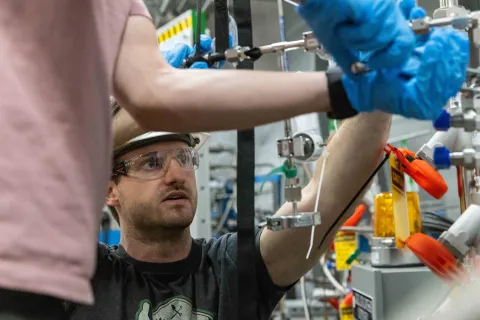
Gavin Cox, a physicist and experiment support scientist at SURF, helps complete one of many hands-on tasks required to keep LZ operational.
photo by Stephen Kenny
Valentino’s main work involves hours staring at computer screens engaged in the labor of data analysis. If LZ were to detect dark matter, it’s one of the researchers, like Valentino, who might be the very first to see that rare signal coming from inside the detector. Staring at numbers and readouts on a computer might seem boring to an outsider, but for Valentino, this is the best part of the job.
“The research is the most exciting part. I also like how everyone's own little piece of work comes together to make something big. It’s exciting doing the analysis and publishing the results. Obviously, we're doing this to find dark matter, which would be really, really cool,” Valentino said.
Like all great undertakings on the planet—from colossal monuments to incredible feats of engineering, to major breakthroughs in physics—it’s the labor of thousands of individuals working together who make it possible.
LZ intends to continue taking data for three more years. Should dark matter someday be detected by this or any other experiment, the subsequent Nobel Prize will be thanks not only to the few who receive medals in Stockholm, it will be thanks to each and every person who took part in the daily grind required to advance world-class research at laboratories like SURF.
Want to know more? Check out this video and don’t miss SURF’s own Dark Matter Day celebration starting at 5 p.m. on Oct. 24, 2024, with the talk A day in the life of a Dark Matter Scientist. Learn more about this event here.
